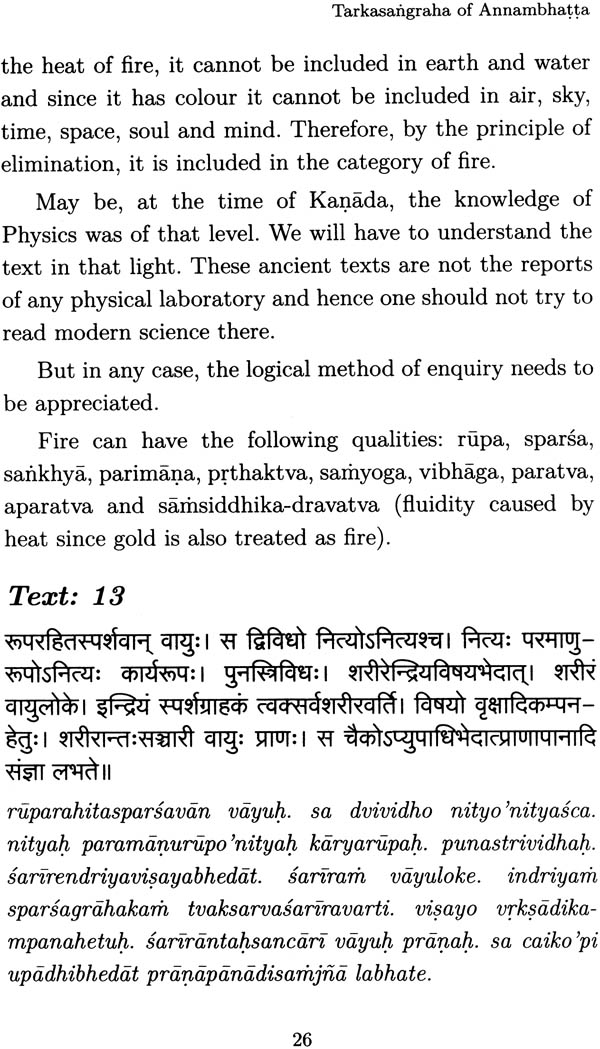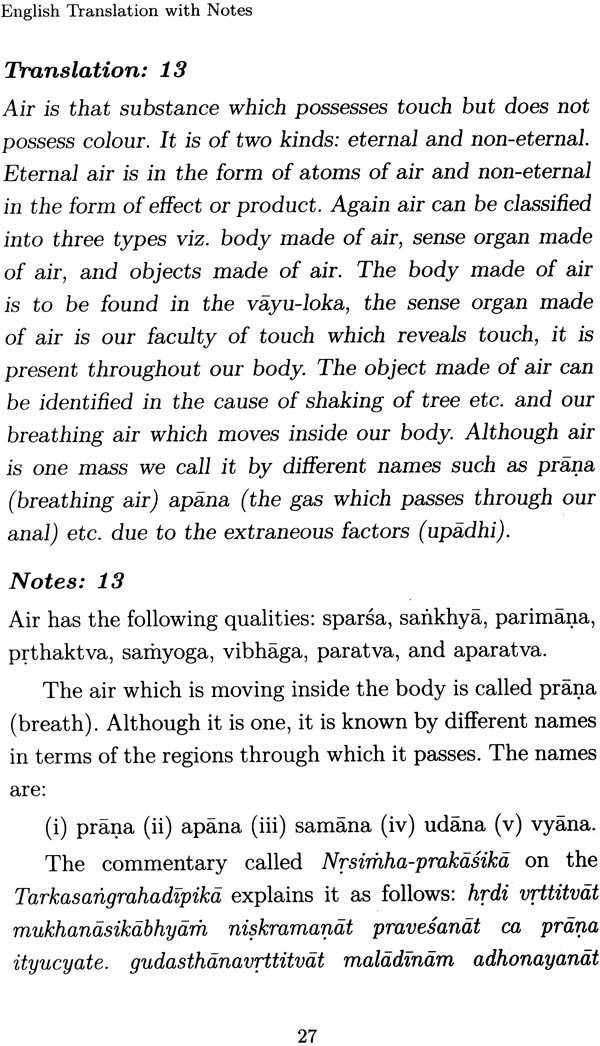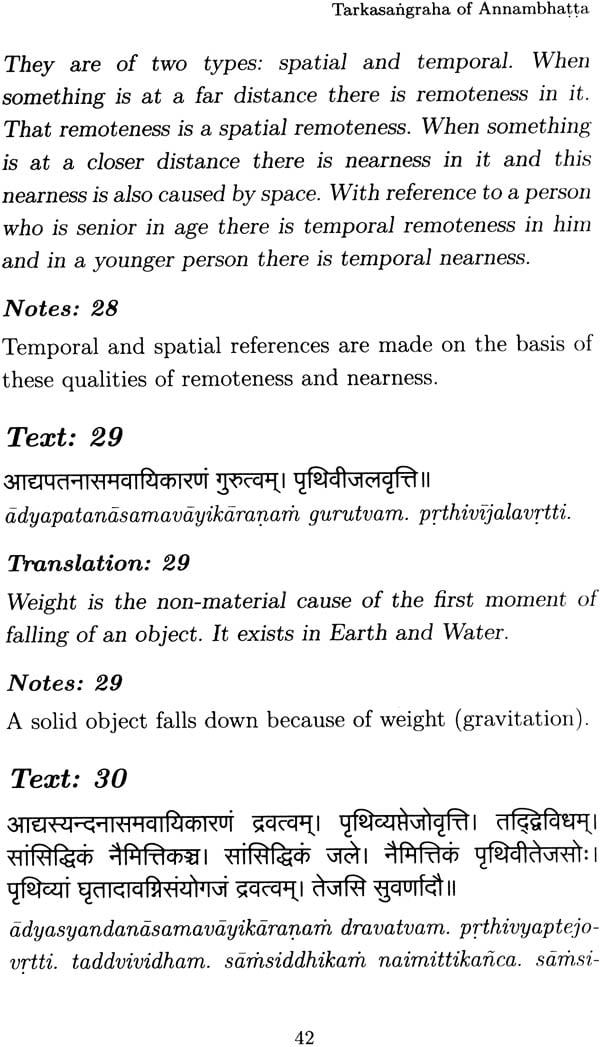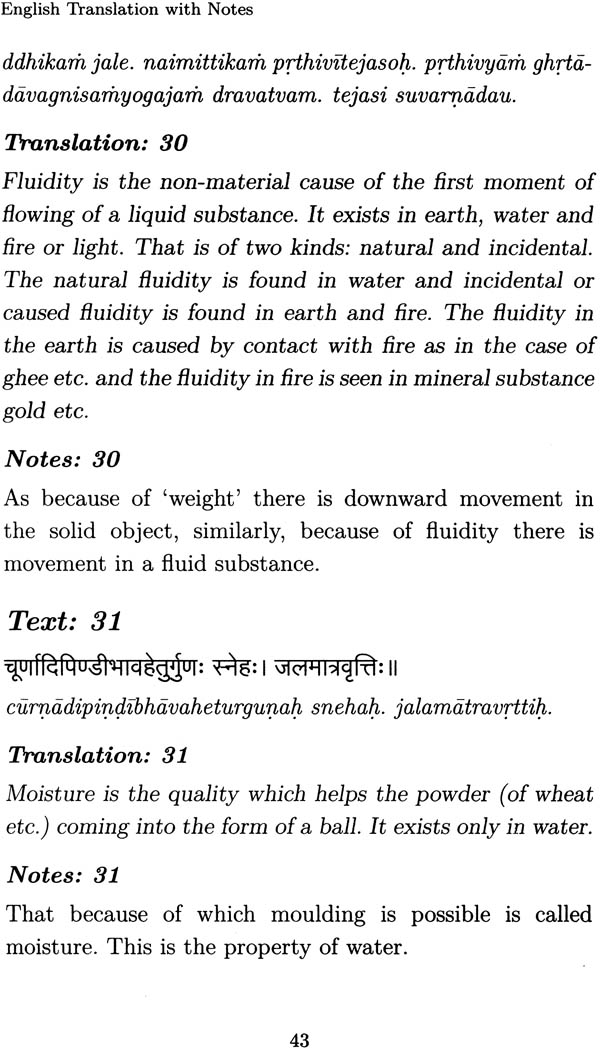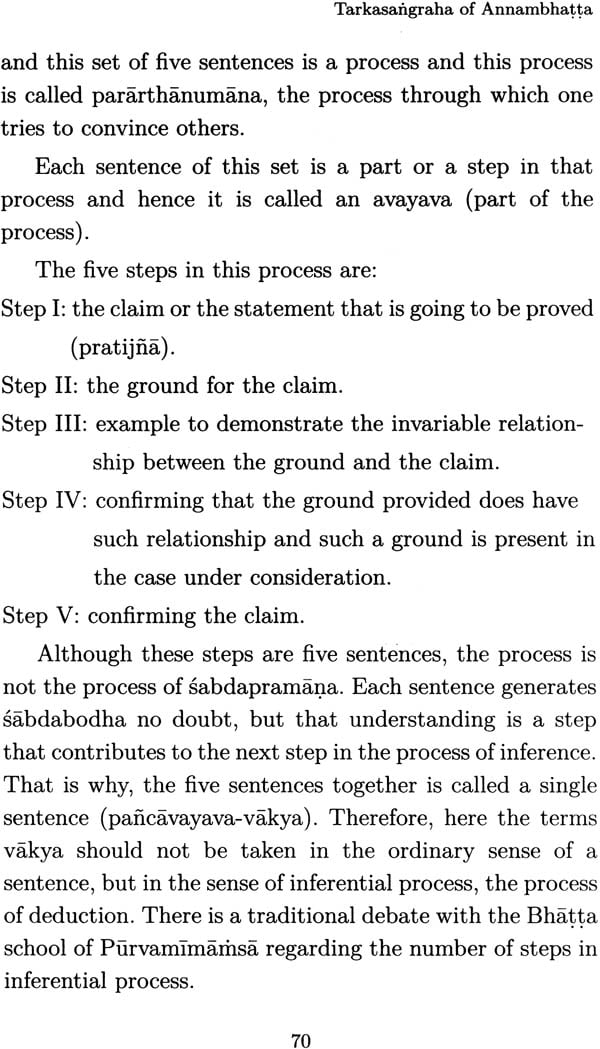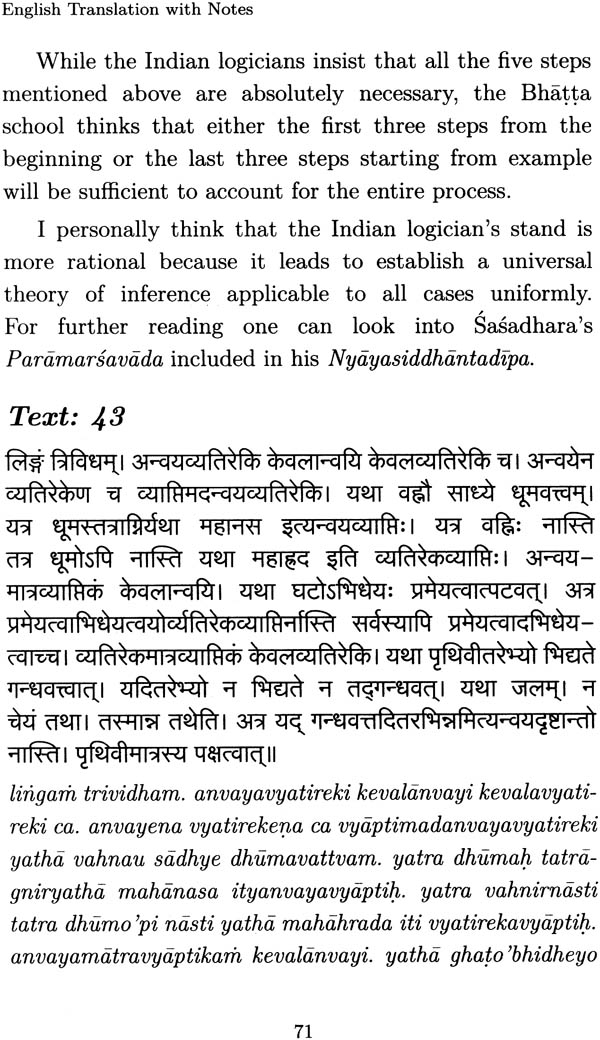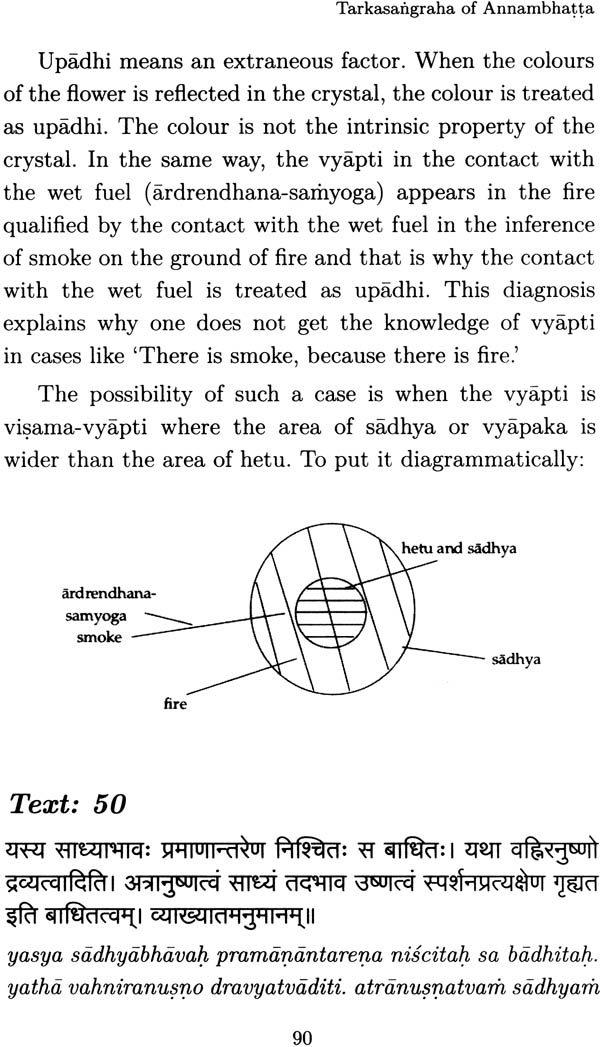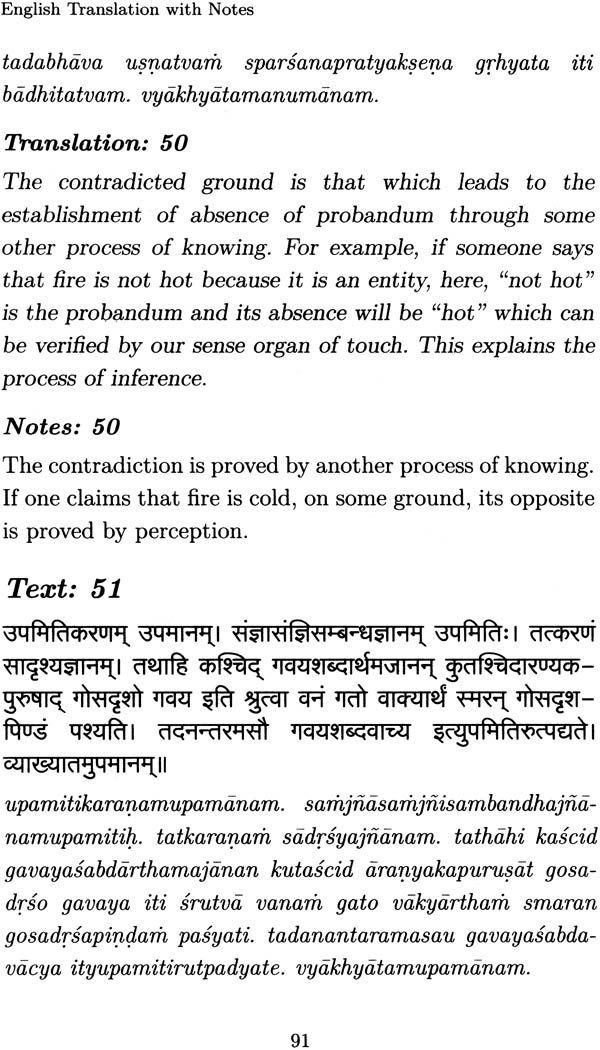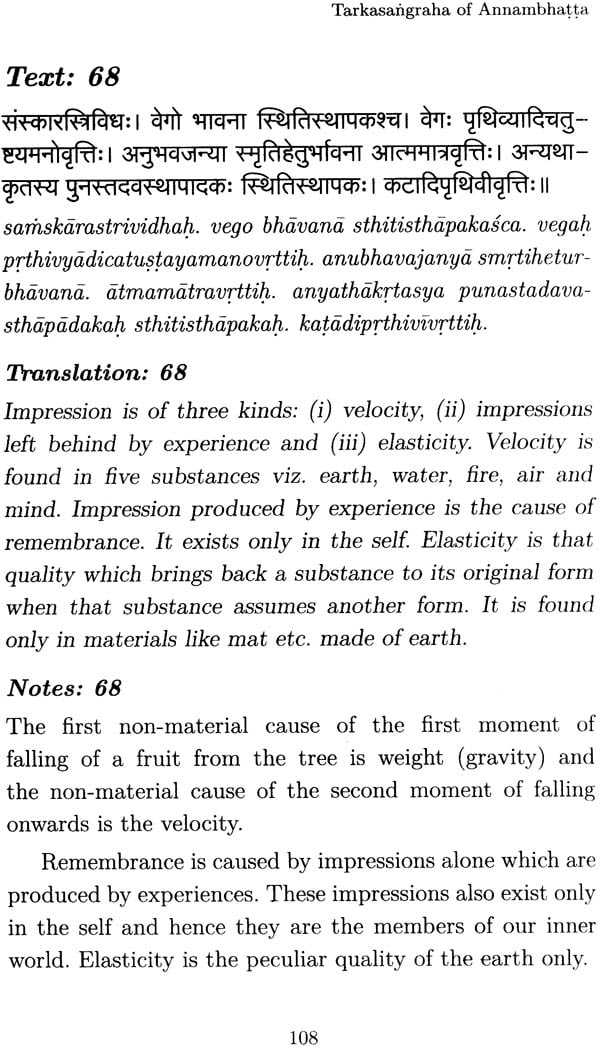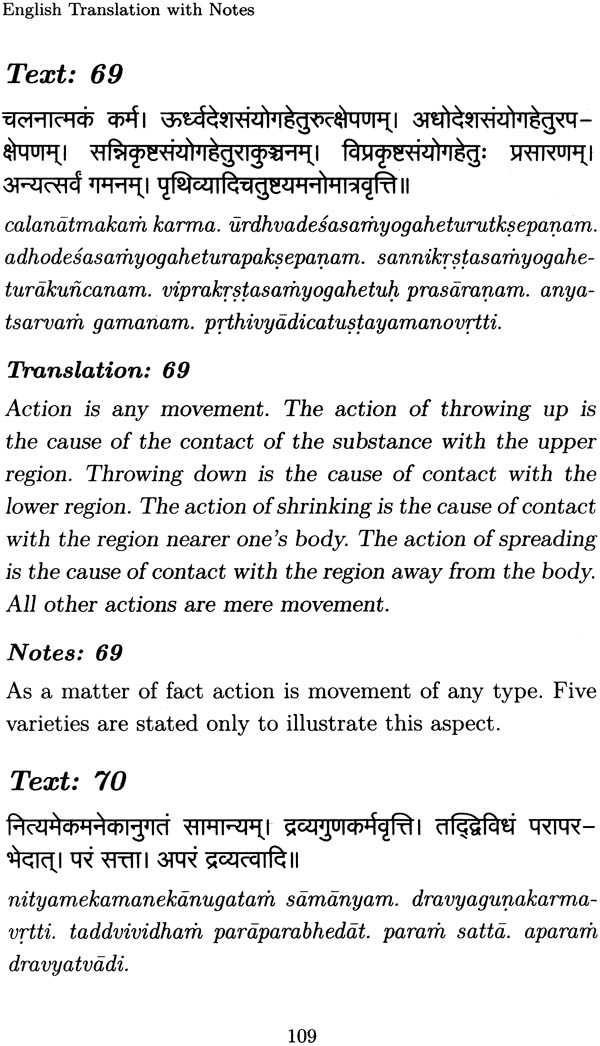
Tarkasangraha of Annambhatta (Sanskrit Text, Transliteration, English Translation with Detailed Explanation)
Book Specification
| Item Code: | NAC895 |
| Author: | V N Jha |
| Publisher: | old CHINMAYA INTERNATIONAL FOUNDATION |
| Language: | Sanskrit Text, Transliteration, English Translation with Detailed Explanation |
| Edition: | 2016 |
| ISBN: | 9789380864037 |
| Pages: | 100 |
| Cover: | Hardcover |
| Other Details | 8.3 Inch X 5.6 Inch |
| Weight | 190 gm |
Book Description
Prof. V. N. Jha (b. 1946), is an eminent scholar and proficient in the various branches of Sanskrit learning. His entire life has been devoted to the promotion and propagation of Sanskrit studies through multi-disciplinary approaches, with the sole intention of keeping the language and studies related to it, relevant in the minds of scholars as well as the laity. Towards this he has worked closely and regularly with the language to create new disciplines of study in Sanskrit. He has contributed over 45 books and over 100 articles. Many students have received their Ph.D degree under his tutelage and mentorship.
Prof. Jha is member of a number of national and international academic bodies and institutions, having been honoured by many of them. He was Professor and Director at the Centre for Advanced Study in Sanskrit, University of Pune — a position he has held for 20 years. He was also the founding chairman of the Special Centre for Sanskrit Studies, Jawaharlal Nehru University, New Delhi.
I feel immense pleasure in placing in the hands of our readers Prof. V. N. Jha’s lucid English translation of Tarkasangraha of Annambhatta with elaborate notes. Although this is a basic text of Nyaya-Vaisesika system of Indian philosophy, it serves as a fundamental treatise to enter into the frame-works of other systems of Indian philosophy too with great ease. That is why; this text is compulsorily taught to all students of all disciplines of knowledge in our traditional educational system. Our world of experience carries names and forms. Here is an attempt in this text to capture the entire world of names and forms through language and that is why, this has become a fundamental text to enter into any intellectual discipline. It is a manual for the beginners. It deals with ontology, logic and epistemology. Although very brief in form, it is presented with profound clarity.
Annambhatta composed Tarkasangraha and also a commentary on it called Dipika in the later half of the 17th Century. He was a Tailanga Brahmin of North Ascot (Chittoor) district of Andhra Pradesh who had settled down in Benaras. He is also the author of Nyayaparisista-prakasa.
Although there are several English translations of Tarkasangraha still one will find that this translation of Prof. V. N. Jha is unique in the sense that it is lucid and simple and is augmented by elaborate explanatory Dotes with diagrams wherever necessary. His graphic presentation of the abstract ideas will immensely help the readers concretize the concepts. An index of Key Terms of Nyaya with their English equivalents and a list of commentaries on Tarkasangraha composed by various traditional scholars are also appended in this volume. Similarly, a detailed Bibliography of various editions of Tarkasangraha along with its 93 commentaries and sub-commentaries have also been appended at the end of the text which will prove to be of great use to the advanced researchers.
The Chinmaya International Foundation Shodha Sansthan feels great joy in bringing out this publication because it will provide a great help to scholars of Indian philosophy in general and Nyaya-Vaisesika philosophy in particular. We are thankful to Prof. Jha for allowing us to publish such a valuable and useful work by the Chinmaya International Foundation Shodha Sansthan. I also thank my colleagues for carrying out all works related to the publication of this volume. We are thankful to Rashtriya Sanskrit Sansthan, New Delhi for the financial assistance to bring out the book. I pray to Guruji and the almighty God for blessings.
I taught this text of Tarkasangraha in the Chinmaya International Foundation (CIF) in June, 2009. Swami Advayananda, the honourable Acharya of Sankara-nilaya, got my lectures video-recorded and made them available in 22 DVDs for the use of the learners of Indian logic and epistemology. He also requested me to prepare one English Translation of this text with elaborate notes for the learners. The present volume is an outcome of his advice.
Swami Advayanandaji’s love for knowledge is indeed admirable. He is compassionate and therefore, is always engaged in preservation and dissimination of ancient Indian wisdom to the generations to come. I express my heartfelt gratitude to him. But for his constant reminder, this volume would not have seen its completion.
Dr. Dilip Kumar Rana, the Director of the Chinmaya International Foundation Shodha Sansthan (CIFSS) came forward to bring out this book on priority basis. He also prepared a detailed Bibliography of various editions of Tarkasangraha which has been appended at the end of this volume. It has enhanced usefulness of this volume. I profusely thank him for this.
Dr. Sheeba Sudheer, the Deputy Director of CIFSS, has done the entire DTP work upto corrections of the final press copy with the help of her colleagues Smt. Sarala and Smt. Ambika. I want to put on record the excellent job done by this team devotedly. Dr. Sheeba may not like my thanking her and so I say: May God bless her!
Smt. Sarala and Smt. Ambika deserve special words of appreciation for adding value to this volume by appending a list of “Key Terms” along with their English equivalents of the Nyaya-Vaisesika system of Indian philosophy and a list of commentaries on Tarkasangraha composed by various traditional scholars. I wish both of them happiness and peace. I also take this opportunity to thank Professor Muraleemadhavan, the dynamic Chairman of the Shodha Sansthan, for encouraging the publication of sastric texts.
I must mention here that the kind tolerance of my frequent absence from home by my wife, Prof. Ujjwala Jha (the Director of the Centre of Advanced Study in Sanskrit, University of Pune) and my daughter, Miss Vedashree Jha (a student of Engineering Science), has contributed immensely towards the completion of this work. May God grant them all that they want.
I have tried my best to make this English translation and Notes as lucid as possible using contemporary idiom and illustrative diagrammes. If it serves the purpose for which it is written I shall consider my efforts amply rewarded. Readers’ suggestions will definitely be considered and incorporated in the next edition of this volume.
aparitosad vidusam na sadhu manye prayogavijnanam!
There are six orthodox systems namely, Sankhya, Yoga, Nyaya, Vaisesika, Purvamimamsa and Uttaramimamsa. Purvamimamsa is referred to as simply Mimamsa and Uttaramimamsa is popularly known as Vedanta. These six systems are called orthodox because they believe in the authoritative-ness of the Vedas.
As against these, there are three philosophical systems which do not believe in the authoritativeness of the Vedas. They are Carvaka, Buddhist and Jaina systems. These are referred to as heterodox systems of Indian Philosophy.
The orthodox systems are also called astika-darana and heterodox systems are known as astika-darana. Here the terms astika and nastika mean that system of thought which believes in the authoritativeness of the Vedas and that system of thought which does not believe in the authoritativeness of the Vedas respectively.
The terms astika and nastika do not mean here ‘one who believes in God’ and ‘one who does not believe in God’ respectively, because the system of Mimamsa is an astika-darana and yet it does not believe in God. Similarly, there is nirisvara-sankhya and sesvara-sankhya (yoga), Vaisesika too did not have God in its sutra-period.
All the six Vedic-philosophical systems were initially formulated in the sutra-style. Kapilamuni composed Sankhya-sutras; Patanjali wrote Yoga-sutras; Kanada wrote Vaisesika-sutras; Gautama wrote Nyaya-sutras, Jaimini composed Mimamsa-sutras and Badarayana composed Vedanta-sutras. The thoughts of these systems developed through a very rich tradition of writing commentaries and sub- commentaries thereon which have recorded the intense dialogues between the heterodox systems on one hand and interorthodox systems on the other. These dialogues have added depth to Indian Philosophical systems.
Like-wise two different interpretations of the Sabara bhasya gave rise to two schools of Purvamimamsa:
(1) Kumarila and (2) Prabhakara. Murari created a third school of Purvamimamsa by commenting directly on the Mimamsasutras of Jaimini.
Indian philosophical systems acquired structural depth because they honored freedom in thinking and respected others’ positions at intellectual levels. That is why we find that whenever a particular system takes up an issue for discussion it presents first of all what others have to say on that issue. Even Carvaka’s view is not ignored. It is a different matter whether others’ views are to be accepted or rejected, but this could not be done without critical examination. The Vaisesika and the Nyaya systems were distinct in the beginning. God did not find a place in the Vaisesika School and abhava as an entity was not discussed in the Nyaya School. But gradually there was give and take between these systems and by the 10th Century A.D. we find that these two systems have merged into one system due to their similar world-views. Thereafter these systems have been referred to by a combined name Nyaya-Vaisesika.
It appears that there has been intense debate between the Naiyayikas and the Buddhist logicians and philosophers for at least one thousand years, if not more, over a number of philosophical issues. Whether there is something called substance or not, where qualities are located; whether there is a whole independent of its parts or not, whether there is self or not, whether absence should be given a status of an entity or not, whether there is necessity of accepting philosophical God or not many such issues engaged the attention of these philosophers. This dialogical literature of one thousand years is called Pracina-nyaya. It consists of the Nyayasutras of Gautama, Nyaya-sutra-bhasya of Vatsyayana, Nyayasutra-bhasya-varttika of Udyotakara, Nydyasutrabhasyavarttikatatparyattika of Vacaspatimisra and Nyayasutrabhasyavarttikatatparyatikaparisuddhi of Udayanacarya (10th Century A.D.).
This bulk of literature is an outcome of an issue- oriented dialogue and hence Pracina-Nyaya may be characterized as prameya-pradhana.
The 10th Century A.D. seems to be the turning point in the development of Nyaya-Vaisesika thought. There is a shift of emphasis from prameya to pramana (epistemology). This turning point gave birth to what is known as Navya Nyaya. From this period onwards we find that the Nyaya-Vaisesika philosophers are engaged in preparing a precise language of discourse. They discovered that during the Pracina-Nyaya period many a time the communication remained ambiguous because the language of discourse was ordinary Sanskrit language and hence they decided to develop Navya Nyaya language which can be used for ambiguity-free communication in any field.
Once this language was developed by the Century AD., all thinkers and philosophers adopted this very Navya Nyaya language to analyze a thought and wrote books in their respective fields of discourse. This language became so popular that not only the Nyaya-Vaisesika Philosophers but even the thinkers of Mimamsa, Vedanta, Vyakarana, Alankarasastra and Dharma-sastra wrote books in this language and even today the same language is adopted as a tool to analyze ordinary language and represent human thoughts by many traditional scholars.
The magnum opus of this period is the Tattvacintamani of Gangesopadhyaya of Mithila of the 12th or 13th Century A.D. In the year 1976, the Nyayasiddhantadipa of Sasadhara has come to light. This is argued to be prior to Gangesa by Bimal Krishna Matilal who critically edited the text and it was published from the L.D. Institute of Indology, Ahmedabad.
When Tattvacintamani reached Navadvipa (today’s Nadia District of West Bengal), it occupied a central place in the intellectual academic program of that place. Raghunatha Siromani wrote an epoch-making commentary called the D14h1t1 on it. Two great logicians of Bengal wrote two independent and critical commentaries on Didhiti which gave birth to practically two independent schools of Navya-Nyaya. They are Jagadisa Tarkalankara and Gadadhara Bhattacarya of Navadvipa, the place where Caitanya Mahaprabhu started his Bhakti movement. The two schools of Navya Nyaya are popularly known as the Jagadisa-school and the Gadadhara-school and the two commentaries on the Didhiti of Raghunatha are known as Jagadisi and Gadadhari.
As I have already mentioned, the worldview of the Nyaya-Vaiesika system of philosophy and logic accepted the saptapadarthi model of capturing the entire world of human experience through natural language.
This was necessary because the Buddhist idealists as well as the Sankaradvaitins held the view that reality could not be captured by language. The Nyaya-Vaisesika philosophers challenged this position and wanted to demonstrate that nothing can be known unless the world is presented before us with a name and a form. This system did not accept degrees of reality as proposed by Sankaracarya namely, vyavaharika, pratibhasika and paramarthika levels of reality. If x exists, it is real and ultimately real. An atom (paramanu) is as much real as God and a sky-flower is as much fictitious as rabbits horn (sasa-srnga).
Language presents the world with a form and a name and there is no logic to prove that whatever is presented through language is false because that claim will also have to be made only through language.
The Tarkasangraha of Annambhatta (1623 A.D.) is a very small but very profound treatise to introduce this world-view of the Nyaya-Vaisesika system of philosophy with utter clarity. It is a unique hand-book of Indian Logic and Epistemology. The method through which the entire universe has been analyzed through natural language is comparable to any analytic method of sciences and social sciences today. Training in this methodology empowers a serious enquirer to go deeper into any analysis of human mind. It is this reason that this text occupied a unique position in the traditional curriculum of any discipline of knowledge.
| Benediction | vii |
| Preface | ix |
| Acknowledgement | xi |
| Introduction | xiii |
| Text with Translation and Notes | 1 |
| Key Terms | 122 |
| Bibliography | 130 |
| Commentaries of Tarkasangraha | 139 |
